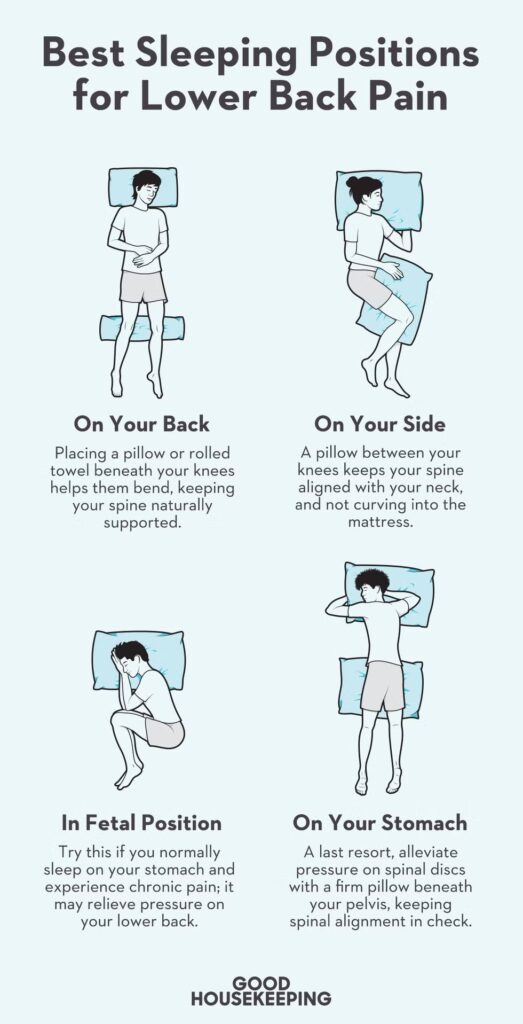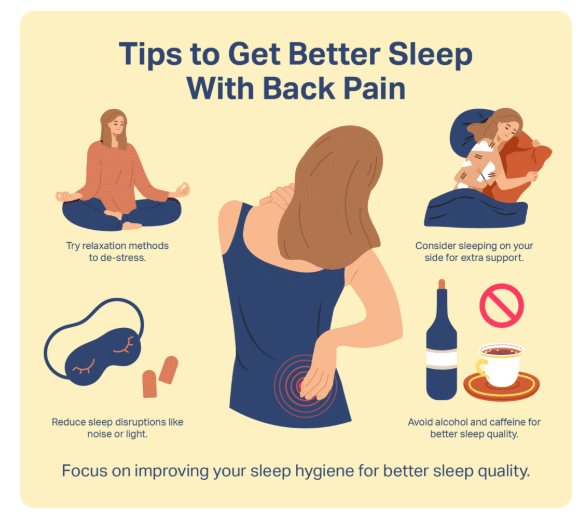Lower back pain is a pervasive issue, affecting nearly 8 out of 10 people at some point in their lives. For many, the discomfort can become more pronounced at night, interfering with quality sleep. But there’s hope. Adjusting your sleeping position and adopting better sleep habits can help alleviate pain and improve your overall rest. Let’s explore how sleeping positions, mattress choices, and other strategies can ease lower back pain.
Why Does Lower Back Pain Worsen at Night?
Lower back pain often intensifies at night due to a combination of factors:
- Sleeping posture: Poor alignment of the spine during sleep can increase stress on the lumbar area.
- Underlying conditions: Arthritis, disc herniation, or sciatica may cause persistent pain when lying down.
- Bed quality: An unsupportive mattress or pillow can exacerbate discomfort.
- Sleep disturbances: Tossing and turning due to pain can create a cycle of worsening symptoms.
Best Sleeping Positions for Lower Back Pain

1. Sleeping on Your Back With a Pillow Under Your Knees
This position keeps your spine in a neutral alignment and evenly distributes weight across your body.
How to Do It:
- Lie flat on your back.
- Place a pillow under your knees to maintain the natural curve of your lower back.
- Add a small rolled towel under the small of your back for extra support.
How It Helps:
By slightly bending your knees, this position reduces tension on the lumbar spine and relieves pressure on your discs.
2. Side Sleeping With a Pillow Between Your Knees
Ideal for side sleepers, this position ensures proper alignment of your hips, pelvis, and spine.
How to Do It:
- Lie on your side with your knees slightly bent.
- Place a firm pillow between your knees.
- Use a pillow to support your waist if there’s a gap between your waist and the mattress.
How It Helps:
The pillow reduces stress on your lower back and prevents twisting of the spine, which can lead to misalignment and pain.
3. Fetal Position
This position is especially helpful for those with herniated discs or spinal stenosis.
How to Do It:
- Lie on your side and curl your knees toward your chest.
- Use a pillow to support your head and keep your neck aligned with your spine.
How It Helps:
Curling your body opens up the spaces between your vertebrae, reducing nerve tension and providing relief.
4. Sleeping on Your Stomach With a Pillow Under Your Pelvis

Although stomach sleeping isn’t generally recommended, adding a pillow under your pelvis can make it more supportive.
How to Do It:
- Lie on your stomach with your head turned to one side.
- Place a thin pillow under your pelvis to reduce strain on your lower back.
- Use a small or no pillow under your head to avoid neck strain.
How It Helps:
This position reduces pressure on the discs in the lumbar spine, especially for those with degenerative disc disease.
5. Reclined Sleeping Position
Sleeping in a reclined position can help if you have isthmic spondylolisthesis or other lower back conditions.
How to Do It:
- Use an adjustable bed or a recliner to elevate your legs and torso.
- Ensure your lower back is supported to prevent sagging.
How It Helps:
Reclining creates an angle that reduces compression on the spine, alleviating lower back pain.
Quick Comparison of Sleeping Positions
| Position | Best For | Key Benefits |
|---|---|---|
| Back Sleeping With Pillow Under Knees | General lower back pain | Maintains spinal curve, reduces lumbar tension |
| Side Sleeping With Pillow Between Knees | Sciatica, scoliosis, hip pain | Aligns hips and spine, prevents twisting |
| Fetal Position | Herniated discs, spinal stenosis | Opens vertebral spaces, reduces nerve pressure |
| Stomach Sleeping With Pelvic Pillow | Degenerative disc disease | Minimizes lumbar strain, prevents misalignment |
| Reclined Sleeping | Isthmic spondylolisthesis | Reduces spinal compression, improves alignment |
Tips for Reducing Lower Back Pain at Night
1. Choose the Right Mattress and Pillow
- Opt for a medium-firm mattress that supports the natural curve of your spine.
- Use a memory foam pillow to cradle your neck and maintain spinal alignment.
2. Practice Sleep Hygiene
- Keep a consistent bedtime schedule.
- Avoid caffeine and alcohol in the evening.
- Eliminate distractions like blue light from screens before bed.
3. Incorporate Gentle Stretches
- Stretching before bed can loosen tight muscles and improve circulation.
- Focus on gentle yoga poses like the child’s pose or cat-cow stretches.
4. Adjust Your Bedroom Environment
- Maintain a cool temperature (around 65°F).
- Use blackout curtains and white noise machines to block light and sound.
When to See a Doctor
While sleeping positions and adjustments can help, some cases of back pain may require medical attention. Consult a doctor if:
- Pain persists for more than a few weeks.
- You experience numbness, weakness, or tingling in your legs.
- Pain is accompanied by fever, weight loss, or bladder/bowel issues.
- Pain worsens at night despite adjustments.
FAQs About Sleeping With Lower Back Pain
1. Can my mattress cause lower back pain?
Yes, an old or unsupportive mattress can misalign your spine and increase pressure on your lower back. Consider replacing it if it’s sagging or too soft.
2. Is stomach sleeping bad for lower back pain?
Stomach sleeping can strain your lower back unless you place a pillow under your pelvis to reduce pressure.
3. Can stretching help with lower back pain?
Yes, gentle stretches before bed can improve flexibility, relax tight muscles, and reduce tension.
4. How do I know if my back pain is serious?
Seek medical attention if your pain is severe, persistent, or accompanied by symptoms like numbness, fever, or difficulty walking.
5. How long does it take to see improvement with new sleeping positions?
It may take a few nights to adjust to a new position and start noticing relief. Be patient and consistent with changes.
Conclusion
Sleeping with lower back pain doesn’t have to be a nightly struggle. By adjusting your position, choosing the right mattress and pillow, and practicing good sleep hygiene, you can find relief and wake up feeling refreshed. If pain persists, consult a healthcare provider for tailored treatment options.
References
- MedlinePlus. Back Pain. National Library of Medicine.
https://medlineplus.gov/backpain.html - American Academy of Orthopaedic Surgeons. Low Back Pain.
https://orthoinfo.aaos.org/en/diseases–conditions/low-back-pain - National Institute of Neurological Disorders and Stroke (NINDS). Low Back Pain Fact Sheet.
https://www.ninds.nih.gov/low-back-pain-fact-sheet - Johns Hopkins Medicine. What Causes Lower Back Pain?
https://www.hopkinsmedicine.org/health/conditions-and-diseases/back-pain - National Library of Medicine. The Association Between Sleep and Chronic Back Pain.
https://www.ncbi.nlm.nih.gov/pmc/articles/PMC4376186/ - FamilyDoctor.org. Low Back Pain.
https://familydoctor.org/condition/low-back-pain/ - Good Housekeeping. Experts Explain How to Sleep Comfortably With Lower Back Pain.
https://www.goodhousekeeping.com - Mayo Clinic. Back Pain – Symptoms and Causes.
https://www.mayoclinic.org/diseases-conditions/back-pain/symptoms-causes/syc-20369906 - National Sleep Foundation. Sleep Positions for Back Pain Relief.
https://www.sleepfoundation.org/sleep-hygiene/sleep-positions-back-pain - Spine-Health. Best Sleeping Positions for Lower Back Pain Relief.
https://www.spine-health.com/wellness/sleep/best-sleeping-positions-lower-back-pain-relief


